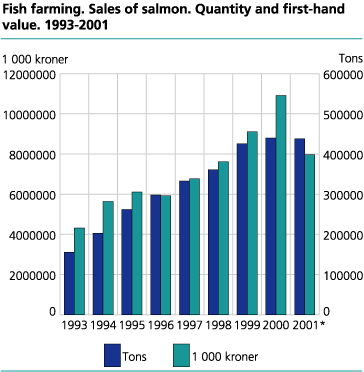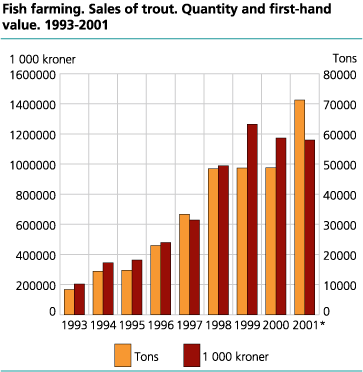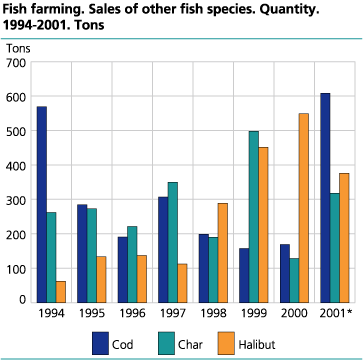Content
Published:
This is an archived release.
Drop in value of farmed salmon
The total sales value of reared salmon and trout came to NOK 9.1 billion in 2001. This is a decline in value of 25 per cent from 2000. The quantity sold was nearly the same.
Sales dropping
The value of salmon sold in 2001 came to NOK 8 billion, the lowest since 1998. The decline of 27 per cent is a result of lower prices. Average price fell from NOK 24.79 in 2000 to NOK 18.17 in 2001. A total of 438 000 tonnes of salmon were sold, nearly the same as in 2000.
A total of 71 000 tonnes of trout were sold, up 31.5 per cent from 2000. In spite of this large increase, the value of trout sold was nearly the same as in 2000. The average price fell from NOK 24.03 in 2000 to NOK 16.26 in 2001
Nordland was still the salmon county number one with 85 000 tonnes of salmon, while Hordaland produced the biggest quantity of trout, almost 18 000 tonnes.
Stable employment
The employment in fish farming in Norway has been stable since 1997. In 2001 there were 3 682 people employed doing just over 5 million man-hours
Mainly men are employed in the production of salmon and trout. The share of female workers has been stable in many years. In 2001, 13 per cent of all the employees were females, accounting for 9.4 percent per cent of all labour input. The number of female workers is larger in the production of fry and fingerlings than in the production of fish for consumption.
Increased loss/wastage in the production of fish for consumption
In 2001 almost 22 million salmons were reported lost or wastaged.. This is an increase of 27 per cent from the previous year, but in proportion to the stocks this lost/wastage is in the same magnitude as the year before. Around 96 per cent of these fish were counted and destroyed, while the rest had either escaped or been eaten by predators.
In 2001 about 272 000 farmed salmon were reported escaped, and this is about the same as in 2000. The number of escaped trout in 2001 was reported to be 95 000, up 27 per cent from 2000.
More biomass
The total biomass of fish in Norwegian fish farms increased. At the end of 2001 the stock of live salmon was 346 000 tonnes, as compared to 328 000 tonnes at the close of the previous year. There were 50 000 tonnes of live trout in fish farms in 2001, a slight increase from 2000.
Cod increasing
Fish farming of other fish species still lags far behind salmon and trout. Farmed cod passed halibut as the third most important species measured by quantity. In 2001, 608 tonnes of farmed cod were sold; being four times the quantity sold in 2000. Sales of halibut, however, dropped from 549 tonnes in 2000 to 376 tonnes in 2001. Other fish species sold as farmed fish in 2001 were char, turbot, mackerel, saithe and eel.
Shellfish sales have not taken off
Preliminary figures for 2001 show that sales have yet to take off. Mussels are still the main species; the 913 tonnes that were sold brought NOK 7.4 million.
Tables:
- Table 1 Fish farming. Sales of salmon and trout. Quantity and first-hand value. 2001
- Table 2 Fish farming. Salmon and trout. Number of workers and labour input, by type of license. 2001
- Table 3 Fish farming. Salmon. Stock of fish for food during the period 1 January 2000 to 31 December 2001. 1 000 pieces
- Table 4 Fish farming. Salmon and trout. Stock of fish for food per 31 December 2001, by generation
Contact
-
Statistics Norway's Information Centre
E-mail: informasjon@ssb.no
tel.: (+47) 21 09 46 42



